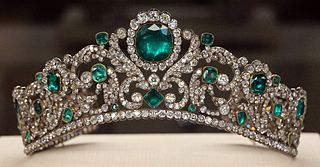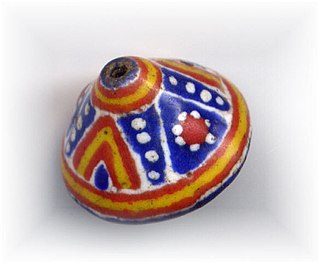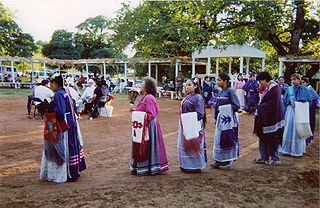
A tiara is a jeweled head ornament. Its origins date back to ancient Greco-Roman world. In the late 18th century, the tiara came into fashion in Europe as a prestigious piece of jewelry to be worn by women at formal occasions. The basic shape of the modern tiara is a semi-circle, usually made of silver, gold or platinum and richly decorated with precious stones, pearls or cameos.

A necklace is an article of jewellery that is worn around the neck. Necklaces may have been one of the earliest types of adornment worn by humans. They often serve ceremonial, religious, magical, or funerary purposes and are also used as symbols of wealth and status, given that they are commonly made of precious metals and stones.

An anklet, also called ankle chain, ankle bracelet or ankle string, is an ornament worn around the ankle. Barefoot anklets and toe rings historically have been worn for at least over 8,000 years by girls and women in Indus Valley, in Indian Subcontinent where it is commonly known as pattilu, payal, golusu and sometimes as nupur. They have also been worn by Egyptian women since predynastic times. In the United States both casual and more formal anklets became fashionable from the 1930s to the late–20th century. While in Western popular culture both younger men and women may wear casual leather anklets, they are popular among barefoot women. Formal anklets are used by some women as fashion jewellery. Anklets are an important piece of jewellery in Indian marriages, worn along with saris.

Moulding, or molding, also coving, is a strip of material with various profiles used to cover transitions between surfaces or for decoration. It is traditionally made from solid milled wood or plaster, but may be of plastic or reformed wood. In classical architecture and sculpture, the moulding is often carved in marble or other stones. In historic architecture, and some expensive modern buildings, it may be formed in place with plaster.

Kiffa beads are rare powder glass beads. They are named after the Mauritanian city of Kiffa, where French ethnologist R. Mauny documented them first in 1949.

A pollera is a Spanish term for a large one-piece skirt used mostly in traditional festivities and folklore throughout Spanish-speaking Latin America. Polleras are made from different materials, such as cotton or wool and tend to have colorful decorations. Most of the decorations are embroidered, flowers and regional animals are among the most common designs found in polleras.

Serbian traditional clothing, also called as Serbian national costume or Serbian dress, refers to the traditional clothing worn by Serbs living in Serbia, Croatia, Bosnia and Herzegovina, Montenegro, and the extended Serbian diaspora communities in Austria, Australia, Bulgaria, Canada, France, Germany, Greece, Hungary, North Macedonia, Romania, Russia, Slovenia, United States, etc. Like any traditional dress of a nation or culture, it has been lost to the advent of urbanization, industrialization, and the growing market of international clothing trends. The wide range of regional folk costumes show influence from historical Austrian, Hungarian, German, Italian, and Ottoman Turkish presence. Nonetheless, the costumes are still a pinnacle part of Serbian folk culture. From the 19th century and onwards, Serbs have adopted western-styled clothing. This change has started in larger settlements such as cities and towns, although it was not uncommon to see rural women in traditional working costumes all the way until the end of 1970s. Today, these national costumes are only worn by some elderly in rural areas but are most often worn with connection to special events and celebrations, mostly at ethnic festivals, religious and national holidays, weddings, tourist attractions, and by dancing groups who dance the traditional Serbian kolo, or circle dance.

A hair drop is an ornament worn by men from Great Lakes and Plains tribes. It would be tied to the man's hair. The typical example consists of a quilled or beaded section on a strip of leather, which was later attached to an American buffalo tail. They could be over two feet long.

The Armenian Taraz, also known as Armenian traditional clothing, reflects a rich cultural tradition. Wool and fur were used by the Armenians along with the cotton that was grown in the fertile valleys. During the Urartian period, silk imported from China was used by royalty. Later, the Armenians cultivated silkworms and produced their own silk.

Khmer traditional clothing refers to the traditional styles of dress worn by the Khmer people throughout history. Tracing their origins back to the early Common Era, the customary styles of dress worn by Khmer people predate the indianization of Southeast Asia. The evolution of these clothing customs can be traced through archaeological artifacts from the 6th century to the post-Angkorian period, evolving from the simple pre-Angkorian Sampot to vibrant and intricately embroidered silk garments.
Ribbon work is an appliqué technique for clothing and dance regalia among Prairie and Great Lakes indigenous peoples.

Native American jewelry refers to items of personal adornment, whether for personal use, sale or as art; examples of which include necklaces, earrings, bracelets, rings and pins, as well as ketohs, wampum, and labrets, made by one of the Indigenous peoples of the United States. Native American jewelry normally reflects the cultural diversity and history of its makers, but tribal groups have often borrowed and copied designs and methods from other, neighboring tribes or nations with which they had trade, and this practice continues today. Native American tribes continue to develop distinct aesthetics rooted in their personal artistic visions and cultural traditions. Artists may create jewelry for adornment, ceremonies, and display, or for sale or trade. Lois Sherr Dubin writes, "[i]n the absence of written languages, adornment became an important element of Indian communication, conveying many levels of information." Later, jewelry and personal adornment "...signaled resistance to assimilation. It remains a major statement of tribal and individual identity."

The turkey dance is one of the most important traditional dances among Caddo people. Women dance the turkey dance, while men drum and sing the songs, which describe events in Caddo history.

Tamil people have historically been connoisseurs of fine golden jewellery, which has a history predating the Sangam period in the Indian subcontinent. Ancient Tamil literature lists out the different types of jewellery worn by women historically from head to toe. Apart from gold, jewellery was also fashioned out of silver, copper and brass.

History of clothing in the Indian subcontinent can be traced to the Indus Valley civilization or earlier. Indians have mainly worn clothing made up of locally grown cotton. India was one of the first places where cotton was cultivated and used even as early as 2500 BCE during the Harappan era. The remnants of the ancient Indian clothing can be found in the figurines discovered from the sites near the Indus Valley civilisation, the rock-cut sculptures, the cave paintings, and human art forms found in temples and monuments. These scriptures view the figures of human wearing clothes which can be wrapped around the body. Taking the instances of the sari to that of turban and the dhoti, the traditional Indian wears were mostly tied around the body in various ways.

Mughal clothing refers to clothing worn by the Mughals in the 16th, 17th and 18th centuries throughout the extent of their empire. Much of them were already being used in the past centuries before their arrival in Indian subcontinent. It was characterized by luxurious styles and was made with muslin, silk, velvet and brocade. Elaborate patterns including dots, checks, and waves were used with colors from various dyes including cochineal, sulfate of iron, sulfate of copper, and sulfate of antimony were used.

The jellabiya, also jalabiya, galabeya or jalamia is a loose-fitting, traditional garment from the Nile Valley. Today, it is associated with farmers living in Egypt and comes in rich color varieties. The garment is also worn in Sudan, but has other textures and is usually white, as well as some communities from Eritrea and Ethiopia. The colorful Egyptian style is used by both men and women.

Buyao is a type of Chinese women's hair ornament. It is a type of Chinese hairpin which was oftentimes decorated with carved designs and jewelries that dangles when the wearer walks, hence the name, which literally means "shake as you go". The buyao is similar to a zan hairpin, except for the presence of its dangling ornaments, which are its primary featured characteristics. The buyao appeared as early as in the Han dynasty, where only noble women in the royal family could wear it. In ancient times, the use of buyao denoted noble status. Some noble women also put buyaos on their tiaras, making their hair decoration more luxurious than simple buyao. Common material used in making the buyao was gold; the ornaments were typically jade and pearls. Other valuable materials could be used, such as silver, agate, etc. Many centuries after the fall of the Han dynasty, the buyao was introduced to ordinary civilians; and when all women were allowed to wear to it, more variety of materials were used to produce them. Buyao was passed down over generations; buyao decorated with pendants are still popular in modern-day China.

Qatari clothing is similar to other Persian Gulf countries, typically consisting of a ghutra, agal, and thawb for men, and an abaya and shayla for women. Face veils, usually either a niqāb or burqa, are sometimes worn by women. Depending on the context and setting, men and women will make micro-adjustments to their dress to better suit the situation, such as tilting the agal for men or loosening the abaya for women in informal contexts. Some differences exist between rural (Bedouin) and urban traditional dress, although these variations are mostly minor and superficial.

Egyptian cultural dress is the clothes, shoes, jewelry, and other items of fashion common to the Egyptian people and recognizable as particularly representative of Egyptian culture.




















